North India travel guide, North India's secrets are all here, including exclusive niche attractions recommendations
Preface
Throughout the history of human civilization, India wasn't the first region to be inhabited. The ancient Babylonians of the Mesopotamian region had vanished, leaving behind fragile remains that lay precariously vulnerable amid the chaotic wars of the Middle East. From Bamiyan to Palmyra, everything was set in stone.
Our great country has a splendid civilization of 5,000 years, but it also has some false self-confidence. For most historical sites, it is inevitable that they will be destroyed and damaged by ignorance.

India, however, is different. It boasts a wealth of well-preserved ancient castles and palaces, yet locals know little about them. As this remarkable nation, with its 1.6 billion people struggling to take off in the pace of modernization, history is also slipping away like a torrent. The complexities and arbitrariness of religion inevitably lead to a diverse and complex heritage. Modern Indians, like those in Egypt, often remain unaware or barely aware of the magnificent legacy left by their ancestors. The syncretic culture established by the great Maurya dynasty was so magnificent, yet it has now become a simple tool for Indians to exploit foreigners. Indians possess a cockroach-like drive for survival and a leech-like susceptibility. Even in the presence of a Chinese practitioner of Tai Chi, they exude a self-assurance that is both ironic and uncanny.

The Taj Mahal, the holy city of Varanasi on the Ganges, Bodh Gaya, Rajasthan, Darjeeling, Kolkata and Mumbai are the main destinations for travelers visiting India, but India's beauty goes far beyond these. The coconut groves and backwaters of Kerala, the ancient temples of Tamil Nadu, the Golden Temple of Punjab, Kashmir and Ladakh are all worth exploring.
 I first visited India in 2017, and during my month-long trip, I visited nearly every major tourist destination in North India, with the exception of Kashmir and Darjeeling. In October 2018, I returned again, adding lesser-known destinations like the Orchha Valley, Sarnath, Ranakpur, and Pushkar during my two-week trip. By then, I had covered nearly every major tourist destination in North India, which culminated in this guide.
I first visited India in 2017, and during my month-long trip, I visited nearly every major tourist destination in North India, with the exception of Kashmir and Darjeeling. In October 2018, I returned again, adding lesser-known destinations like the Orchha Valley, Sarnath, Ranakpur, and Pushkar during my two-week trip. By then, I had covered nearly every major tourist destination in North India, which culminated in this guide.
Of the more than 70 countries I've visited, India is one I both love and hate. This somewhat contradictory feeling led me to set foot on this magical land again. The Indian Ministry of Tourism describes its own country as "Incredible India!" I think it's wonderful. Such a simple word conveys so much, and even after returning home for some time, I still can't get enough of it.
India Travel Overview

The Indian Ministry of Tourism has used the slogan "Incredible India!" to describe the country. This slogan will be reflected throughout your trip, and by the end of your trip, you will sincerely say, "This sentence is so accurate!"
Yes, India is such a magical country. Spend even a single day in India and your perspective on travel will be constantly redefined. India boasts over 20 UNESCO World Heritage sites, numerous magnificent temples and palaces, and a coexistence of modern metropolises and towering slums. The greatest novelty of traveling in India lies in interacting with the locals, with countless daily routines that will both exasperate and amuse you. Hundreds of different curries from around the world are available here, and there are vegetarian and Muslim options, along with a wide variety of religious customs. Meet the cattle roaming the streets and the monkeys snatching food from your hands in the palaces. Try the local street food or a freshly squeezed glass of Indian salted lemonade, then treat yourself to diarrhea at the hotel.
That’s right, this is India. When traveling here, please put aside your ladylike temperament and gentlemanly demeanor. Completely breaking the rules is the real fun of traveling in India!
Unreliable Indian

The biggest challenge of traveling independently in India is being tricked countless times daily. Indian tricks are often just clever little tricks, seemingly slapstick in the face of a 5,000-year-old culture. However, Indians are notoriously shameless and will relentlessly pursue you, constantly hoping to trick you, which can be off-putting. Furthermore, Indians are known for their slowness and unpunctuality. They often say they'll wait 20 to half an hour after saying they'll wait 5 minutes. Whenever you ask, they'll always say "on the way." While locals are welcoming and welcoming, they can also be incredibly unreliable. For example, when asking for directions, Indians might simply point to a random direction when they're unsure, out of respect. It's crucial to ask multiple people to avoid unnecessary detours. Delhi's prices are among the highest in the country, and the pressure on residents is immense. It's common to see commuters rushing around. It seems both working and living in the capital are challenging. English education has been popularized in India. From the elderly to children, everyone can speak English, but it has a curry flavor. It is interesting to imitate it if you are interested.
To understand India, watch movies first
3 Diots (2009)

Slumdog Millionaire (2009)

My God

Apply for an Indian visa

Visa type: Electronic visa
Application Method: Apply online.
Application Website: indianvisaonline.gov.in/visa.
Visa Validity: 120 days. Applicants must apply at least four days before their intended arrival
. Length of Stay: Up to 60 days, with double entry
permitted. Processing Time: Generally no more than 72 hours.
Visa Fee: US$80 + 2.5% handling fee.
Required Documents:
1. Completed online application form.
2. Scanned electronic copy of the passport front page.
3. Electronic copy of a square ID photograph.
Tips: Starting from December 2, 2016, if you have a Pakistani visa in your passport when applying for any type of Indian visa, you will be required to attend an interview. (It is possible that you do not need an interview in practice. Please be prepared for the interview for the sake of caution.)
Entry and exit transportation

airplane
Flying to major cities such as New Delhi, Kolkata, Mumbai, Chennai, Bangalore, and Cochin is the main way for travelers to enter India. To check flight and ticket information in and out of India, you can use www.makemytrip.com or www.cleartrip.com.
In addition to taking flights from major cities such as New Delhi, Kolkata, and Mumbai, you can also travel from India to Nepal through several land checkpoints between the two countries. The most important checkpoints are Kakabita (near Darjeeling), Birgunj (near Patna and Bodh Gaya), and Sunori (near Varanasi). Chinese passport holders entering Nepal from India can obtain a Nepal visa on arrival at the border.
There is a land checkpoint from India to Pakistan, located near Amritsar, but travelers holding Chinese passports cannot go through customs directly here. If you already hold a Pakistani visa, you can take the international train from Amritsar to Lahore, Pakistan twice a week to go through customs, but due to the tense relations between the two countries, customs clearance takes a long time.
Please be careful not to bring red sandalwood logs, Indian medicines, uninspected and unquarantined food, etc. into or out of the country to avoid being investigated and punished by customs.
train

When visiting India, you absolutely must experience the train! While it's rare to see trains in tourist cities these days, riding a train with Indians is still a truly local way to experience the local culture!
Tips: There has been a similar guide before that summarizes how to book train tickets on the Indian Railways website. During my first trip to India, I tried to book the Agra-Jaipur train, but it was too cumbersome. I advise everyone to give up and go directly to the train station or the agent (travel agencies everywhere) to help with the booking.
India's train network is comprehensive, with frequent trains connecting all major cities. Indian trains are safe – some rumors about people skipping trains and leaving their tickets unpaid are exaggerated.
Trains are categorized by class, from high to low: 1A, 2A, 3A, SL, and 2S. 3A and above are air-conditioned. A 1A ticket costs approximately 300-400 RMB, and the next lower class is roughly half that. A 2S is significantly cheaper. Train ticket prices vary depending on the frequency of the train and the distance covered, so they can't be generalized.
How to book tickets?
It is much easier for foreigners to book tickets in India than for locals - there are special ticket offices for foreigners that book tickets for foreigners and provide travel advice.
To book a train ticket, you need: passport, rupee cash
Taking New Delhi Railway Station as an example, you first need to fill out a form at the foreigner booking office on the second floor of the west side. One form can be used to purchase two train tickets and includes information such as passport number, name, date, departure station, and train number.
After confirming your departure date, you need to check the train schedule with the staff. Some trains do not run every day, so you need to pay attention.
Then you draw a number and pay. The whole process can be completed in half an hour if it is done correctly, but it is best to leave two hours in advance. Don't ask me why.
bus

Buses are also the most common inland transportation in India. India operates very mature Volvo air-conditioned buses. The upper deck can accommodate two people side by side to form a relatively private air-conditioned space. If you cannot book a suitable train, the bus is also a good choice.
Tuk Tuk

Tuk-tuks are the most common means of transportation in the city, and battling cunning tuk-tuk drivers is a daily pleasure. Common tactics used by tuk-tuk drivers include:
1. The road to the hotel you were going to was closed (they actually wanted to take you to another hotel where they could get a kickback)
2. The hotel you are going to is on fire (if you insist on going, he will say so)
3. I'll take you to a tourist attraction. It's really fun and free (actually, you can take them to a shopping mall).
4. If the place you want is 100 rupees, bargain for 50, and then get on the tuk-tuk (the tuk-tuk driver may ask for five or ten times the price, so you have to bargain hard)
5. Okay, get in. 20 rupees. (Once you get off the bus, the driver will immediately change the price and say 20 rupees per person, so 60 rupees for three people.)
Didi Taxi

India has a very convenient taxi-hailing app called Ola. It's recommended to download and install it before your trip so you can use it immediately after your trip. It's worth noting that Ola drivers generally don't speak English very well. If you're having trouble communicating over the phone, ask someone nearby who speaks good English to help you.
Currency and consumption levels
Currency Exchange

As of November 4, 2018, the exchange rate of US dollars to Indian rupees is 72.4, and the RMB can be simply converted to 10:1.
Upon arrival at the airport, you can exchange a small amount of money (recommended US$100) for transportation to your hotel and phone card fees. India is a country with a liberal foreign exchange policy, and currency exchange booths are readily available in tourist cities.
It's recommended to exchange Indian rupees with US dollars; most Chinese yuan cannot be exchanged. Furthermore, credit card fees in India are very high. Except for regular shopping malls and duty-free shops, most small shops will charge an additional 5%-8% fee (some even require an additional 18% government tax). India supports Visa and MasterCard credit cards, but UnionPay support is less robust.
Savings cards with VISA and MASTER can be used to withdraw cash from ATMs on the streets of India. According to my personal experience, the exchange rate is very good. China Merchants Bank charges an additional US$2 handling fee, which is still good.
In addition, you can save 50 rupees by paying with a credit card at almost all major attractions in India, which is incredible and unreasonable!
UnionPay
Although UnionPay's support is limited, HSBC banks in India accept UnionPay withdrawals. HSBC branches can be found in major cities like Delhi, Mumbai, Kolkata, and Jaipur. UnionPay launched its India service in January 2017. Over 90,000 merchants and 70% of ATMs in India accept UnionPay cards. In India, all ATMs operated by ICICI Bank, Axis Bank, Union Bank, Punjab National Bank, Canara Bank, and 41 other banks and financial institutions accept UnionPay cards for rupee cash withdrawals.
consumption level
India is one of the most polarized countries in the world. For travelers who love luxury, India can provide luxury travel services such as palace hotels for hundreds or even thousands of dollars. For frugal backpackers, India is one of the cheapest travel destinations in the world.
India is a vast country with uneven development across its states, resulting in varying consumption levels. Generally speaking, prices are higher in South India than in North India, and higher in larger cities than in smaller ones. In North India's major tourist cities, the cheapest hotel costs only 200-300 rupees per night, a liter of bottled water is 15 rupees, a cup of milk tea is 5-15 rupees, and a small plastic bottle of Coca-Cola is 30 rupees.
tip
Tipping isn't a custom in India, and it's not a traditional tipping country! All Indians asking for tips stems from their greed and the fact that we tourists have conditioned them. If you're not happy, feel free to not tip! Tipping isn't required in regular restaurants. Fine dining restaurants often add a 10% service charge to the bill, so if that's not included, a small tip is fine.
Telephone and Internet
The main mobile phone operators in India are Airtel, Aircel, Reliance, TATA, BNSL and Vodafone. Local rates are very cheap, while domestic roaming charges are slightly higher.
Airtel is the top choice for the best nationwide network coverage, with reasonable rates. International texts cost 6 rupees each, and calls to China cost 9 rupees per minute. However, Aircel's international plans offer the best value, though the signal is a bit weak, with calls to China costing 5-6 rupees per minute. Coverage varies slightly between cities, with Airtel offering the best signal in Delhi. You can apply for and top up your SIM card at your carrier's branch or at roadside stalls marked with ISD/STD.
Tips:
Foreign tourists can go to a business office or street stall with their passports, make a copy of their passports and get the card on the same day. Three hours later, they can call the operator and activate it according to the English prompts.
The Wi-Fi in Indian hotels is generally slow, and some newly built hotels even charge for it.
Safety
Indians are often lustful but fearless, acting like paper tigers with bluffing, posing little threat to independent travelers. Furthermore, India is largely religious, so overall security is relatively safe. However, avoid traveling alone at night, especially if you're a single woman. Keep valuables and important documents with you and take good care of them. Avoid leaving them in public places like hotel rooms to prevent theft or loss. Delhi is full of scams, so be wary of locals offering help, such as tourist advice or directions. Be wary of taxi and tuk-tuk drivers offering to scam you.
Medical treatments and Indian miracle drugs

Although India's overall external environment isn't particularly good, due to the wealth gap, private hospitals are well-equipped with both hardware and software, with relatively few patients and widespread distribution. Their medical staff speak English. Registration fees range from 80 to 100 rupees, and prescription drugs are very affordable. There are also many roadside pharmacies, often marked with green medical signs (the Apollo chain is a common example), where daily medications can be easily purchased. In addition, toiletries and health supplements are also available.
Indraprastha Apollo Hospital is India's largest international hospital chain, with locations in major cities.
Tips: India is known as the world's pharmacy. When you travel to India, you can buy some OTC medicines for your relatives and friends. Eyelash growth liquid (drops for treating glaucoma), boba god oil, anti-inflammatory cream, weight loss pills, and nasal spray are all good choices.
India travel advice
1. Tickets for Indian attractions are divided into two prices: foreigners’ prices and Chinese prices. The price difference is about 5-10 times, which is normal. Don’t be surprised. Don’t waste time arguing with attractions. This is India (in addition, using a credit card generally costs 50 rupees less than using banknotes).
2. There are many scenic spots in India that charge extra for cameras (mobile phones are not charged). Some attractions require additional fees to purchase photography tickets for both mobile phones and cameras. There are also some incredible attractions where photography is free but videography is charged. Attractions such as the Alkasdam Temple and the Sarnath Museum strictly prohibit the entry of any electronic devices and photography is also prohibited. Please comply with local Indian laws.
3. Many ancient forts in India (such as the Red Fort in Agra and Jahangir Palace in the Orchha Valley ) are infested with wasp nests. Locals sometimes provoke wasps to attack tourists and offer them lemons or medicine, pretending to help them and charging exorbitant fees. Be sure to take precautions before entering these scenic spots! Remember, remember, remember!
4. Pay attention to personal safety, avoid going out alone, avoid unsafe places, and avoid going to remote places at night.
5. Do not accept food, drinks, cigarettes, etc. offered by strangers. Avoid the misuse of drugs, which may cause property damage. Be wary of criminals who may try to accost you and take advantage of you for illicit purposes; avoid being deceived.
6. Credit cards and bank cards are not accepted in some areas of India. Please bring sufficient funds for your trip. If you find yourself short on funds, please contact your family, friends, or employer in China immediately. They can wire the required funds to you via Western Union. You can withdraw your funds at any bank or post office offering Western Union services in any Indian city by presenting your valid ID and the code provided by the sender. At international airports, hotels, and banks, you can exchange US dollars or other international currencies for local currency at the prevailing exchange rate.
7. During your trip to India, please take good care of your luggage and carry-on items such as your passport, air tickets, money, and camera, especially in public places such as airports, train stations, restaurants, shops, and tourist attractions. This can prevent loss or theft of these documents and valuables, which could disrupt your trip. Keep your passport with you at all times; it is not recommended to carry it in your luggage. Please make a copy of your passport data page and Indian visa, and keep these copies, along with several passport photos, separate from your original documents for future reference.
8. Please refrain from bringing or purchasing rare plants and animals as this may violate the law and result in travel restrictions. According to Indian law, unprocessed sandalwood is strictly prohibited from export. Bringing sandalwood crafts in excess of personal use will result in fines and confiscation. Other prohibited items, such as ivory, rhino horn, rare animal furs, and rare woods and plants, are protected. Those found guilty of buying, selling, carrying, mailing, or shipping these items out of the country will face fines or legal action.
9. Pay attention to traffic safety, obey traffic rules, choose safe transportation, and avoid overloaded vehicles. India is a right-hand drive country. If you are unfamiliar with local road conditions and do not have a valid local driver's license, do not rent a vehicle to travel.
10. In addition, according to the laws of our country, after the implementation of the "New E-Commerce Law" on January 1, 2019, carrying large amounts of Indian medicines out of the country may be considered smuggling by customs and face criminal imprisonment and punishment. Please do not carry large amounts of medicines out of the country!
Start your trip to North India
For the author, both of my trips to India were concentrated in North India. Although there are great differences between the north and south of India, and Darjeeling and Kashmir are even more mysterious, for travelers with limited time (continuous travel time of less than 1 month), it is recommended to focus on North India. This guide will also revolve around North India.
Delhi & New Delhi
Experiencing India often starts with Delhi.
Delhi offers a glimpse into India's rich history and splendid ancient culture, as well as a glimpse into the country's recent rise from poverty and independence. It also serves as a prime base and transit point for travelers to other northern Indian destinations. The Old City of Delhi, located in the north of the city, served for a considerable period as the capital of the Mughal Empire, and is therefore home to numerous historical sites and ruins. New Delhi, the post-independence capital (also built by the British), has undergone a complete overhaul and has become the economic and administrative center of India.
Swaminarayan Akshardham Temple



In my opinion, this attraction is as stunning as the Taj Mahal and a must-see in India!
The temple is very new, dedicated in 2005 to the Hindu Lord Swami Narayan. Construction involved 3,000 volunteers and 7,000 artisans. It's the largest Hindu temple complex in the world, and is listed in the Guinness Book of World Records! The temple also features an evening light show, but I didn't go due to time constraints (hopefully, it won't be as disappointing as the Red Fort in Delhi).
As for who this Vaminarayan was, the temple details his legendary life. Judging from the murals, it doesn't seem that impressive, but it simply tells of a young man who traveled the Himalayas and later gained the support of wealthy Indians. As a spiritual leader, wealthy people loved to come and pay their respects, leading to the construction of this magnificent temple.
Tips:
Photo requirements: It is worth noting that this temple does not allow electronic products to enter at all. Mobile phones and cameras must be stored in bags, and security checks are extremely strict. Don't take chances!
Ticket Price: This temple is free!
Qutub Minar


Its appearance is very similar to the Minaret of Jam in Afghanistan and the Tower of Babel in Mesopotamia, Iraq! This makes me particularly fond of this world cultural heritage!
At 73 meters, Qutb Minar is India's tallest ancient minar. It's known as the "Victory Minar" because it was built to celebrate the Central Asian Muslims' victory after their successful conquest of India. The minar tapers gradually from base to top, blending Hindu and Islamic influences. It's inscribed with ancient Arabic verses from the Quran and a variety of intricate patterns. The lower three floors are constructed of red sandstone, a vibrant ochre color, while the upper two floors are constructed of white marble. Previously, visitors could hike to the summit for a bird's-eye view of Delhi, but unfortunately, access is now restricted due to a stampede during a summer camp organized by an Indian school, resulting in casualties.
The mosque within the site is India's oldest Islamic mosque. When Islam arrived in India, stonework from 20 nearby Hindu temples was dismantled to build the mosque, which features an iron-pillared atrium, a cloister, and a prayer room. Behind the mosque stands the unfinished Areminar. (Originally, plans included a minaret taller than the Qutb Minar, but the project was aborted due to the emperor's death.)
There is also an iron pillar in the scenic area (Indians are very proud of the fact that it has never rusted). This iron pillar is also the prototype of the Monkey King's golden hoop in Journey to the West. It is a pillar that supports the sky and is very eye-catching.
Tips:
Photo requirements: You can take photos as much as you want at this attraction, and no additional camera fees will be charged.
Ticket price: 600 rupees
Humayun 's tomb

It represents the pinnacle of Indian architecture during the Mughal period. It is a worthwhile attraction and is also a World Cultural Heritage! (Although I had to give up the Panorama of India itinerary due to time constraints)
Built in 1556, Humayun's Tomb is the mausoleum of Humayun, the second emperor of the Mughal Empire. It embodies a unique blend of Islamic and Hindu architectural styles. Constructed of red sandstone, the main structure is square with four gates and a semicircular roof. The entire structure is majestic and magnificent, a masterpiece of Indian and international architectural history.
The sarcophagi of Humayun and his wife are placed in the center of the palace, and the sarcophagi of five Mughal emperors are placed in the palaces on both sides. In 1993, UNESCO listed Humayun's Tomb as a cultural heritage site on the World Heritage List.
Tips:
Photo requirements: You can take photos as much as you want at this attraction without any additional charge, and video recording will be charged an additional 25 rupees (this concept is very tasteless)
Ticket price: 600 rupees
Lotus Temple

The Lotus Temple, a Baha'i temple, has been officially visited by more people than the Eiffel Tower and the Taj Mahal (I wonder where the official confidence comes from). Its exterior resembles a design copied from the Sydney Opera House, but slippers are required to enter the interior, which is otherwise empty. Admission is free.
Raj Ghat
 This is a boring attraction that regular tour groups like to visit. And since Gandhi's ashes were scattered into the Yokohama River and the Indian Ocean after cremation, his remains are not buried here. Admission is free.
This is a boring attraction that regular tour groups like to visit. And since Gandhi's ashes were scattered into the Yokohama River and the Indian Ocean after cremation, his remains are not buried here. Admission is free.
National Museum, Delhi

Seriously, the museum does have some wonderful artifacts, like the Buddha's relics. However, the museum's care and display are truly lacking. They'd start decorating the exhibition halls before the artifacts were even stored. They even shamelessly added a "Northeastern Indian Folklore" section. This is Southern Tibet, isn't it? Unpleasant Indians. Tickets are a bit high at 650 rupees.
Rashtrapati Bhavan & Parliment House
One of the few tourist attractions in New Delhi, it's located at the end of India Gate. It's illuminated at night (very conspicuous, perhaps to avoid being a target for terrorists). It's said to have over 300 rooms and a Mughal-style garden with a water lily fountain. However, since you can't enter, this attraction is pretty useless. Admission is free (though of course, you don't have to pay to see it from the outside).
Red Fort
Although it was designated a UNESCO World Heritage Site in 2007, it's far inferior to the Red Fort in Delhi! You can just take photos from the outside; there's really not much to see inside. I recommend spending half a day or a full day to fully appreciate the Red Fort in Agra. The entrance fee is 650 rupees (550 by credit card), and they've even increased the price. What a rip-off.
India Gate, New Delhi
A dull and uninteresting attraction. During World War II, Indian soldiers were forced to fight for independence by the British, only to be exploited. After the war, the British built the India Gate, modeled after the Arc de Triomphe in Paris, to commemorate the fallen Indian soldiers, without mentioning independence at all. This is a disgrace for India. However, Indians, inherently optimistic, have no limits. They continue to take selfies with their cheap phones in front of this shameful gate and post them on Facebook, hoping to earn a few likes. Admission is free.
Agra
The Taj Mahal is not in New Delhi, but in Agra!
This explanation is often given to those who haven't traveled to India. As the home of the Taj Mahal, Agra is India's most popular tourist city. Under the Taj Mahal's glare, two other UNESCO World Heritage sites in Agra seem remarkably understated: the Agra Fort in the city center and Fatehpur Sikri, the "City of Victory" on the outskirts of the city. Both were once capitals of the Mughal Empire and are well worth a visit.
Taj Mahal
One of the New Seven Wonders of the World! The top destination for millions of travelers visiting India! India's most beautiful architecture, bar none!
Rabindranath Tagore described the Taj Mahal as "a tear on the cheek of eternity." This mausoleum, hailed as "the most beautiful building in the world," is a must-see for all travelers to India. Every year, more than twice the total population of Agra makes the pilgrimage through the Taj Mahal's Islamic-style arches to the tomb of Queen Mumtaz Mahal.
The Taj Mahal, built by Shah Jahan, the fifth Mughal emperor, in memory of his late Persian queen, Mumtaz Mahal, was designated a UNESCO World Heritage Site in 1983. Mumtaz Mahal was Shah Jahan's third wife and the niece of his father, Emperor Jahangir's 20th wife. In 1630, Mumtaz Mahal contracted an illness and died at the age of 38 while giving birth to their fourteenth child. Before her death, she made four final wishes to Shah Jahan, one of which was for him to build her the most beautiful mausoleum in the world. The heartbroken emperor personally oversaw the construction, commissioning the most renowned architect of the time to model the building after Humayun's Tomb, blending Persian, Muslim, and Indian styles. Beginning in 1632, tens of thousands of workers and a massive expenditure of resources took 22 years to complete this unique mausoleum. The main mausoleum of the Taj Mahal is built primarily of pure white marble and is inlaid with gemstones from around the world, including turquoise, jade, and crystal from China, lapis lazuli from Afghanistan, sapphires from Sri Lanka, and agate from Arabia. Except for the side facing the Yamuna River, the Taj Mahal is surrounded on three sides by jagged red sandstone walls.








Tips:
Ticket price: 1100 rupees (yes, the price has increased)
Photo requirements: No extra charge for either SLR or mobile phone. There will be a special photographer in the scenic area to arrange group photos. You can get it for 100 rupees after bargaining. It is a good price-performance ratio and you can try it.
The Taj Mahal has three gates. The West Gate is the main entrance, through which all tour groups enter. Long lines often form on weekends and holidays, but tour groups usually enter after 7-8 PM, so arriving early can help you avoid the crowds. The East Gate is the main entrance for independent travelers in the early morning, and can also create long lines during peak season. The South Gate opens at 8 AM, so if you want to watch the sunrise, you can't enter through the South Gate.
Tips: The ticket office and baggage storage for the West and South Gates are located directly at the entrance, while the East Gate's ticket office and baggage storage are located in Shilpgram, about 1 km from the East Gate entrance. For safety reasons, the Taj Mahal has strict security checks, with separate lines for men and women. Only the following five items are allowed inside: transparent bottled water, small video cameras, cameras, mobile phones, and small wallets. Before entering the Taj Mahal, be sure to check in any prohibited items at the baggage storage area to avoid being stopped at the gate.
Perfect spots for photographing the Taj Mahal:
Savoring its beauty lies in its varying appearances at different times and in different lighting conditions. In the early morning, it's a warm golden orange; in the daytime, it's a brilliant white. At dusk, the white Taj Mahal gradually changes from golden yellow to pink and dark red, and then, with the rising moon, to a silvery white. Upon entering the Taj Mahal at sunrise, don't be too amazed. Instead, rush to the bench in front of the central pool in the garden before the crowds. This is the perfect spot for photographing the Taj Mahal and its reflection. A few steps further, to the fountain in front, you can also capture beautiful reflections of the Taj Mahal without crowds. From the corners of the mosques on either side, you can capture the Taj Mahal through its domes.
If you plan to visit Agra Fort early in the morning to watch the sunrise over the Taj Mahal, the best spot is to enter the Fort, walk through the palace on your right, find an east-facing window, and wait for the sun to rise behind the Taj Mahal. The view is truly breathtaking. After watching the sunrise, you'll find that Agra Fort is sparsely populated in the early morning, and the light is particularly beautiful. In the evening, the north bank of the Yamuna River, opposite the Taj Mahal, is another great spot to watch the sunset over the Taj Mahal. You can walk to the Yamuna River from a path next to the Moonlight Garden (Mehtab Bagh). However, the riverbank is now covered in half-man-high barbed wire and is guarded 24 hours a day by the military, so there are no boats available.
For travelers who are determined to take a boat to the Yamuna River to photograph the Taj Mahal, they can walk along a small path north from the east gate of the Taj Mahal to the Yamuna River. If you are lucky, you can wait for a small boat that is cleaning up garbage on the river, pay some money, and ask the boatman to take you to the river. Many National Geographic photographers completed their Taj Mahal blockbusters in this way.
Agra Fort (Red Fort)


Yes, it is the Agra Red Fort that I mentioned, which is more beautiful than the Delhi Red Fort.
This fort, with a history of over 400 years, was used by several Mughal emperors, including Akbar, Shah Jahan, Jahangir, and Aurangzeb. It was listed as a World Heritage Site in 1983. Because its palaces and walls are entirely built of red sandstone, it is also known as the Agra Red Fort, sharing the same fame as the Delhi Red Fort.
Passing through Jahangiri Mahal and Shah Jahani Mahal, you'll notice the transition from red sandstone to white marble. Shah Jahan, in his love for marble, painted the existing red sandstone white. Then, at Khas Mahal, you'll find the pure white marble palace built by Shah Jahan, with exquisite paintings adorning the walls. The geometrically symmetrical gardens adjacent to the palace are Anguri Bagh, once a royal vineyard. To one side of the garden is the octagonal pavilion, Musamman Burj. Legend has it that in his later years, Shah Jahan was imprisoned here by his son, Aurangzeb. He gazed at the Taj Mahal daily, yearning for his deceased wife. Upon learning of this, Aurangzeb cruelly blinded his father, depriving him of this sole source of comfort. He spent the remaining eight years of his life in this state. After his death, his body was transported via the Yamuna River to the Taj Mahal for burial.
Tips:
Ticket price: 550 rupees (50 rupees discount when showing your Taj Mahal ticket). There is a sound and light show at Agra Fort every night, telling the history of the Mughal Empire. The ticket price is 150 rupees. You can inquire at the ticket office, but the sound and light effects are average and not recommended.
Photography requirements: Mobile phones and SLR cameras can be used free of charge.
Fatehpur Sikri

This fortress briefly served as the Mughal capital from 1571 to 1585 and was designated a UNESCO World Heritage Site in 1983. Although somewhat overshadowed by the Taj Mahal and the Red Fort, it's well worth a visit. At the time, Emperor Akbar (the third emperor of the Mughal dynasty and grandfather of the one who built the Taj Mahal) was childless and prayed to the saint Sheikh Salim Chishti. After the birth of his first son, Akbar, in gratitude, built this fortress and named it Fatehpur Sikri, meaning "City of Victory," and relocated his capital there. However, Akbar's rule lasted only 14 years before he abandoned the city due to water shortages and returned to Agra, where it became deserted.
This Sikri was the imperial tutor of Emperor Akbar. Legend has it that Akbar, in his quest for national unity, married wives from three different religions: Hindu, Muslim, and Christian. (The palaces of these wives are also located within the Fatehpur Sikri Palace.) At the time, Emperor Akbar, troubled by his lack of offspring, approached Sikri, who initially refused. Later, upon hearing of this, Sikri's son pleaded for his help. Sikri then produced a ruby and handed it to Akbar, who then gave it to his Hindu wife. Soon after, his wife became pregnant, and Sikri's son died that same day.
Tips:
Admission: The mosque is free, but the palace is charged. Foreign tourists pay 500 rupees per person. You can get a 10 rupee discount by showing your Taj Mahal ticket when buying the ticket.
Photography requirements: You can use mobile phones and SLR cameras to take photos without paying extra fees.
You need to take off your shoes to enter the mosque. It is recommended to bring your own bag to avoid the shoe fee.
Along the way, you might encounter locals offering help, but politely decline. They'll often try to take you shopping at nearby stalls. If someone offers to explain the sights of the mosque, listen if you're interested. A small fee, no more than 100 rupees, will be charged. If you're not interested, politely decline. There will be many vendors around the mosque, hawking all sorts of goods. Avoid buying anything, as the quality is average, and if you do, you'll likely be surrounded by even more vendors.
{/tips}
Jama Masjid Agra

The Jama Masjid was built in 1648 as a tribute to King Shah Jahan for his favorite daughter. "Jama" means "Friday," referring to the Friday prayers observed by Muslims. Similar in appearance to the Jama Masjid in Delhi, it is much smaller and shoes are not permitted. Admission is free.
Akbar's Mausoleum
Akbar the Great was the third emperor of the Mughal Empire. Along with Ashoka of the Maurya Empire, he is considered one of the two most accomplished emperors in Indian history, both in civil and military matters. It is said that Akbar designed and built the mausoleum himself, and it was finally completed by his son Jahangir in 1613. The mausoleum blends Muslim and Hindu architectural styles, constructed primarily of red sandstone. The entrance to the mausoleum is marked by a majestic gateway flanked by four perfectly symmetrical white marble towers. A large garden leads to the main tomb, which is distinctly different from Humayun's Tomb. The four-story building is constructed entirely of red sandstone, with the lower three floors. Akbar's empty sarcophagus is housed in a marble pavilion on the top floor, while his actual remains are buried in the mausoleum's basement. Admission is 100 rupees.
Mehtab Bagh Moonlight Garden
The best place to watch the sunset over the Taj Mahal. Chandni Chowk is located on the banks of the Yamuna River, directly opposite the Taj Mahal's botanical gardens. Its unique location offers a perfect spot to admire the Taj Mahal from a distance, away from the crowds. Note that Chandni Chowk performs a cappella music performance at 6 PM, so if the sun hasn't set yet or the weather isn't good, you might want to be prepared to take photos. Admission is 200 rupees.
Jaipur, the Pink City

Officially enter the journey to the Four Color Cities of North India!
When you first step into Jaipur with a romantic vision of the "Pink City", the scene before you may be very depressing. The traffic in this largest city in Rajasthan is chaotic, the buildings on both sides of the road and the street vendors are in disarray, the rickshaw drivers stare at the tourists who have just arrived in the local area from the station like flies, and the air is filled with dust and exhaust gas. It is completely impossible to see any pink sentiment in this "Pink City" if you don't know its glorious history.
In the mid-19th century, Edward VII visited Jaipur. As a token of hospitality, the then Maharaja Ram Singh ordered that all the street-facing sides of the houses in the city be painted pink. This decree has been maintained ever since, and since then, Jaipur has had a romantic nickname - the "Pink City".
Today, the pollution brought on by modern urban development has made it difficult to see the charm of Jaipur's former "Pink City." However, in the old city, you can still see Rajasthan's most exquisite City Palace, the ancient Jantar Mantar Observatory, and the charming Palace of Winds. You can also visit the Amber Fort on the outskirts of the city, or gaze down at Jaipur from the hilltop Tiger Fort at sunset, and you can still recognize the glory of Jaipur in the past.
Chand Bawri, Step Well

It is still a popular tourist attraction. Now the best camera positions have been blocked and people are not allowed to go up there. People can no longer go down to the water well (before 2017, you could bribe the police to take popular photos in the afternoon), so it is a very useless attraction.
This attraction is halfway to Mehrangarh Fort. Along the way, there's a group of Indians selling peacock shoes, who are constantly shouting. Ignore them. Continue driving for about 15 minutes until you reach a small hilltop opposite a reservoir. There, an elderly woman sells steamed buns for a very low price. You can buy some and feed them to the monkeys (whom the woman has domesticated). You can also shoot a long and interesting interactive video.
Amber Fort
That’s right, this is the filming location of Guerlain’s epic advertising masterpiece "One Thousand and One Nights", which is as majestic as the Great Wall.
Amber Fort (also known as Ammer Fort) is located on a hill in the northern suburbs of Jaipur. It was built in 1592 by Man Singh, the Maharaja of Ammer. Because the fort is constructed of creamy white, pale yellow, rose-red, and pure white stone, it resembles amber from a distance and is often referred to as the Amber Fort. The fort covers a vast area and comprises numerous independent palaces, blending Rajput and Islamic architectural styles. Built into the hillside, it is a truly spectacular sight. The most famous of these is the Palace of Mirrors, whose walls are inlaid with countless small mirrors and gemstones (now replaced with fakes). At night, candlelight illuminates the palace, creating a myriad of reflections.
Tips:
Ticket price: 500 rupees
Photography requirements: You can use mobile phones and SLR cameras to take photos without paying extra fees
Hawa Mahal Palace of the Winds
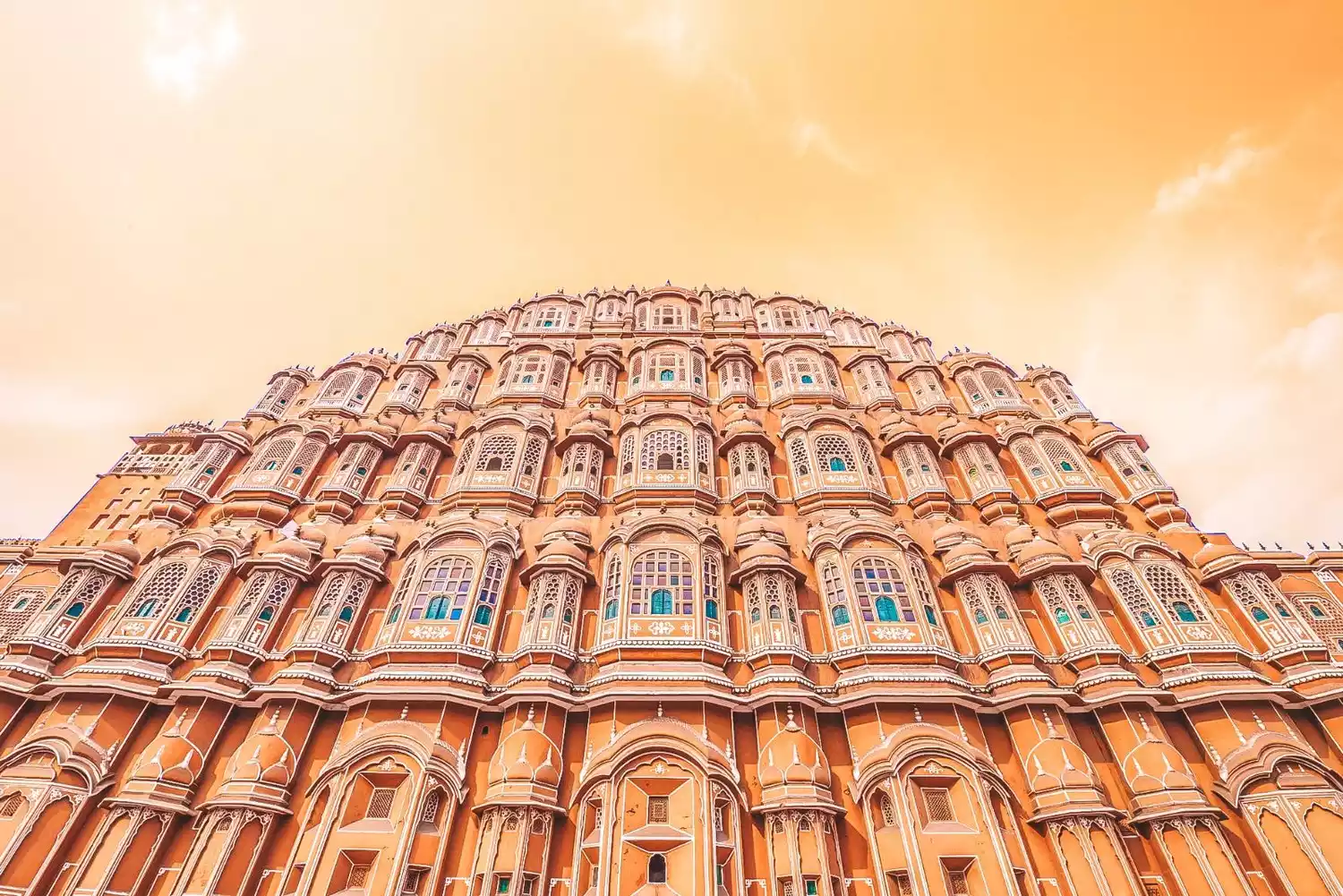
This iconic building, a landmark of Jaipur, was built specifically for the royal concubines of ancient times, allowing them to gaze out at the world through its windows when bored. It looks nice in photos, but seeing it in person wasn't quite as impressive. Everyone loves taking photos at the Tattoo Cafe across the street. Personally, I think bringing a super-advertising lens is even more important!
The Palace of Winds is a landmark building in Jaipur. It was built in 1799 and is located next to the City Palace. It is shaped like a huge pink "wall" with 953 honeycomb-shaped windows densely packed on it. It is made of hollowed-out red sandstone and is semi-octagonal. This structure prevents wind from blowing in from anywhere in the palace. In windy weather, as long as the windows are opened, the strong wind will blow through the front and back windows and will not blow the building down. The palace is therefore named "Palace of Winds".
Tips:
Ticket price: 200 rupees (it is not recommended to enter, there is nothing inside)
Photography requirements: You can use mobile phones and SLR cameras to take photos without paying extra fees
City Palace

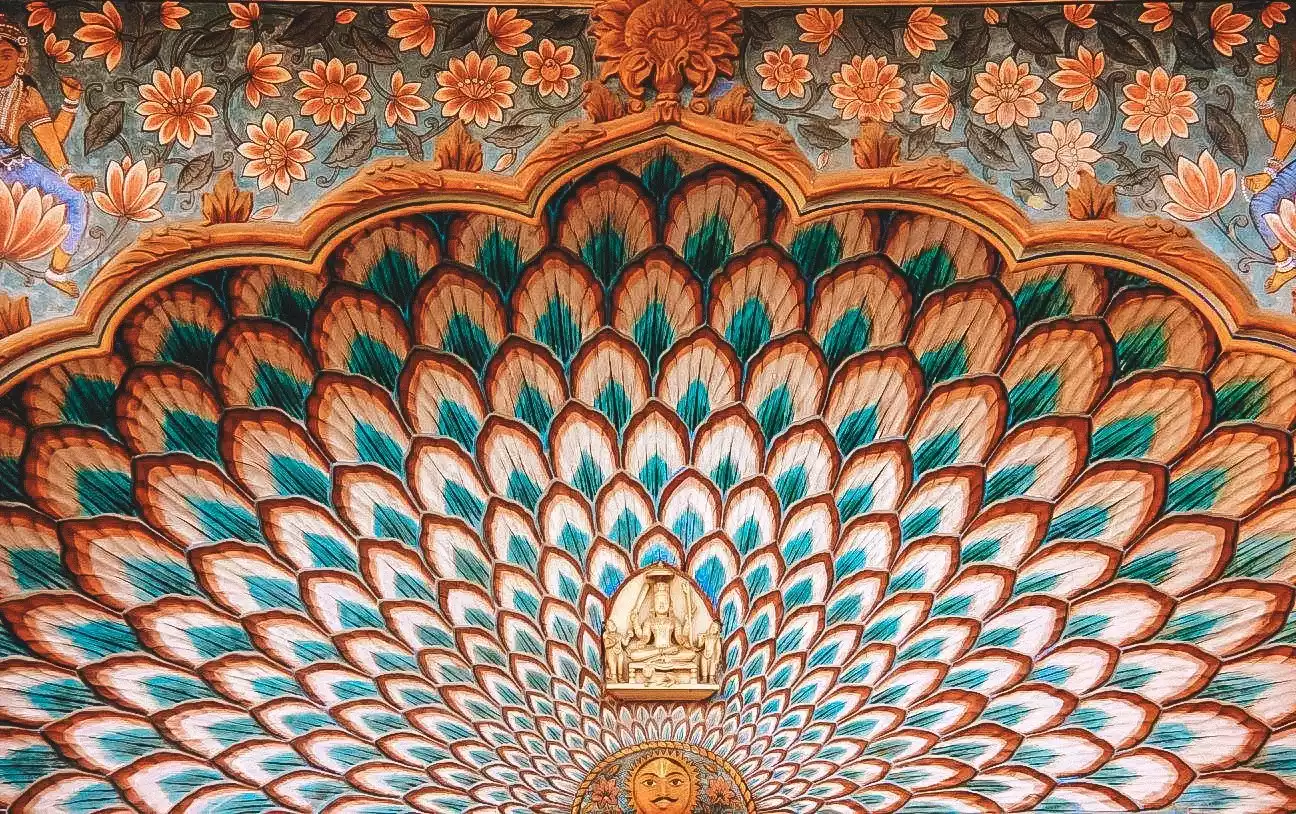

There are many city palaces in North India, and this will be the first one you come across.
When Jai Singh II planned the city, he placed the Maharaja's palace at the heart of Jaipur's old city. The City Palace, built in 1729 and expanded over the centuries by successive maharajas, blends Rajasthani Indian and Mughal Islamic influences.
Most striking features are the two silver urns in the private hall, where the maharaja and his ministers met. Each stands 1.6 meters tall and weighs 345 kilograms, making them the largest pieces of pure silver in the world. In the early 20th century, when the maharaja traveled to England for the coronation of the King, the urns held enough holy water from the Ganges for bathing during his journey.
To the east of the private hall is the public hall, featuring four gates that rotate in time, each depicting a different season, each beautifully carved. The maharaja's descendants still reside here (to determine whether the royal family is at home, simply look for the flag hoisted on the roof of the building).
The most enchanting attraction in this palace is the bathing pool in the harem. The emperor's bedroom is on the second floor, and the scene of the princesses bathing below can be broadcast live. You can just turn over whose card you want and have sex with them. It is truly an imperial enjoyment.
Tips:
Ticket price: 200 rupees
Photo requirements: Camera is free, video is 200 rupees (this is also strange).
Nahargarh Fort Tiger Fort
Tiger Fort is less famous than Amber Fort, but fortunately, it's a relatively unpopular attraction with relatively few foreign tourists, making it a pleasant place to visit. Originally built as a fortress to protect Jaipur, it has since fallen into disuse, but its imposing presence remains. It offers the best viewpoints overlooking Jaipur, and watching the sunset from here is especially recommended. Tickets are only 50 rupees.
Jantar Mantar
The observatory was built by Maharaja Jai Singh II, an avid astronomy enthusiast. He built five observatories throughout his life, with the one in Jaipur being the best preserved. The sundial, theodolite, meridian instrument, and the 12 zodiac signs are all fascinating to see, and the aerial view would be even more fascinating. Admission is 200 rupees.
Jal Mahal Water Palace
This palace, built by the Maharaja of Amer in the late 18th century as a summer retreat, is located halfway between Jaipur and Amber Fort. The palace itself is not open to the public, but from a distance, it appears to float on the water. (Udaipur also has a water palace, which we'll discuss later.) Admission: Admission is limited to viewing from a distance and is not permitted inside.
Blue City Jodhpur
Like Chefchaouen in Morocco, India's Blue City of Jodhpur isn't particularly blue, so those looking for panoramic shots should plan accordingly. However, the city is not without its own highlights. It's home to India's most luxurious five-star hotel, the Umaid Bhawan Palace (also a museum), and boasts many popular Instagram-worthy spots, including the Mayur Blue houses and the Moon Well, making it well worth exploring.
Meherangarh Fort


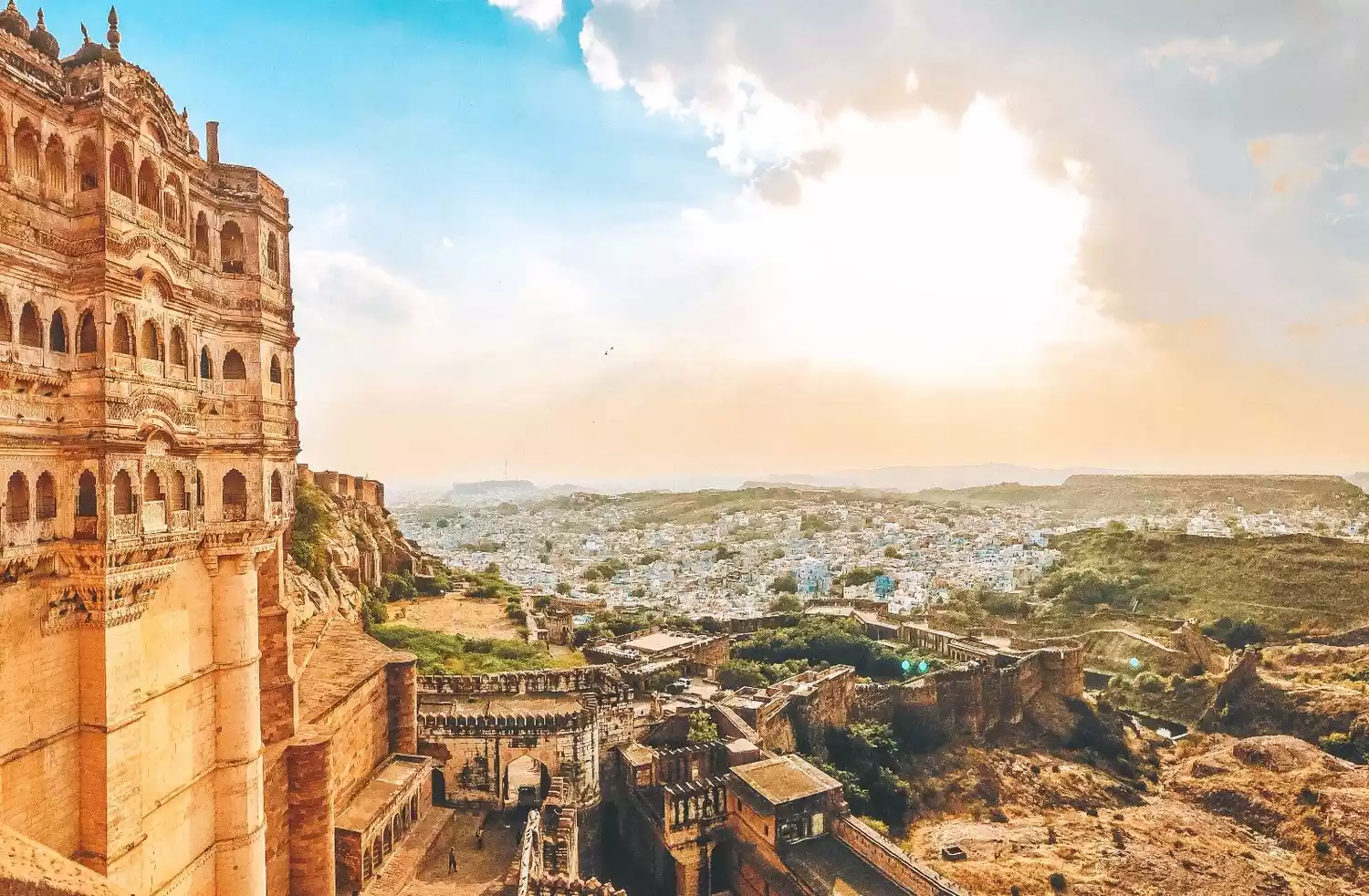

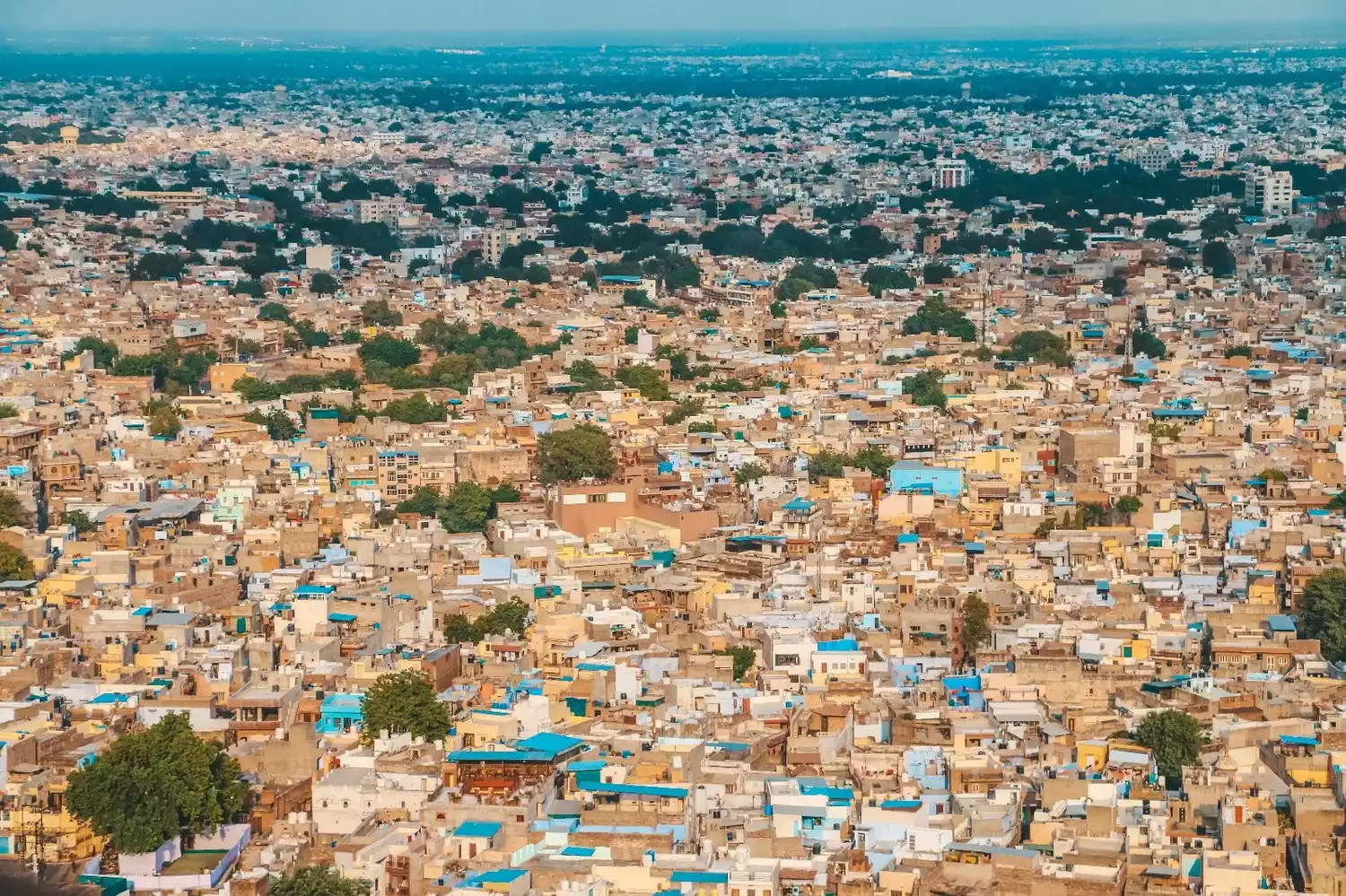
Built in 1459 AD by Maharaja Rao Jodha of the Rathore dynasty, the fort stands atop a 125-meter-high cliff. Its beige exterior features seven gates, built by different maharajas at different times. From the foot of the mountain to the summit, a spacious bridle path stretches 5 kilometers, passing through seven gates, each with its own story.
This will be the first true castle you visit on your trip to India, and it's also one of the more impressive castles on the entire trip. From here, you can enjoy a beautiful panoramic view of Jodhpur, with the five-star Umaid Bhawan Palace in the distance. There's also a great restaurant where you can watch the sunset and enjoy a romantic candlelight dinner (recommended price: 200 RMB). Don't forget to browse the museum and souvenir shop, where you'll find unique, creatively designed figurines, available only here.
Tips:
Ticket price: 600 rupees
Photo requirements: Camera 100 rupees, no requirement for mobile phone
Jaswant Thada




I have to say, this place is absolutely stunning! Unlike the Taj Mahal, the most important thing is that there are no tourists!
This place is often referred to as the Jaswant Thada by some Chinese, but this is inaccurate. The Jaswant Memorial, located on a small lake 1 km northeast of Mehrangarh Fort, was built in memory of Maharaja Jaswant Singh II. However, according to local sources, Jaswant Singh II's remains are located in present-day Lahore, Pakistan, making this claim inaccurate.
With few tourists, it's a quiet spot, offering panoramic views of the Blue City and stunning photos of the Mehrangarh Fort from the side. Every morning from 5:30 to 7:30 a.m., a morning folk music concert takes place on the terrace of Jaswant Thada. Feel the sun slowly rise to the melodious rhythms, illuminating the Blue City. The musicians' moving voices echo throughout the city, leaving a lasting impression.
Ticket price: 50 rupees (including camera fee)
White City Udaipur
Surrounded by two lakes, I jokingly call it the Interlaken of India. This city is a favorite destination for European and American tourists, and it boasts numerous top-notch five-star hotels, offering a unique perspective on Indian travel.
Udaipur (also known as Udaipur), the former capital of the Mughal Empire, is one of the most beautiful cities in Rajasthan, India. Known as the White City, Udaipur is also known for its lakes and palaces, earning it the nickname "City of Lakes."
Udaipur City Palace






The second palace on the itinerary is the City Palace. It's the largest palace in Rajasthan and the largest in India. It's enormous, and after several expansions, its shape and size resemble an aircraft carrier! Like other palaces and forts in Rajasthan, the City Palace in the White City blends Rajasthani and Mughal influences with Muslim influences. You can even find hanging gardens here! Notably, unlike the Jaipur City Palace, this one is still run by the royal family, offering the opportunity to live there!
Ticket price: 300 rupees (great value)
Pichola Lake
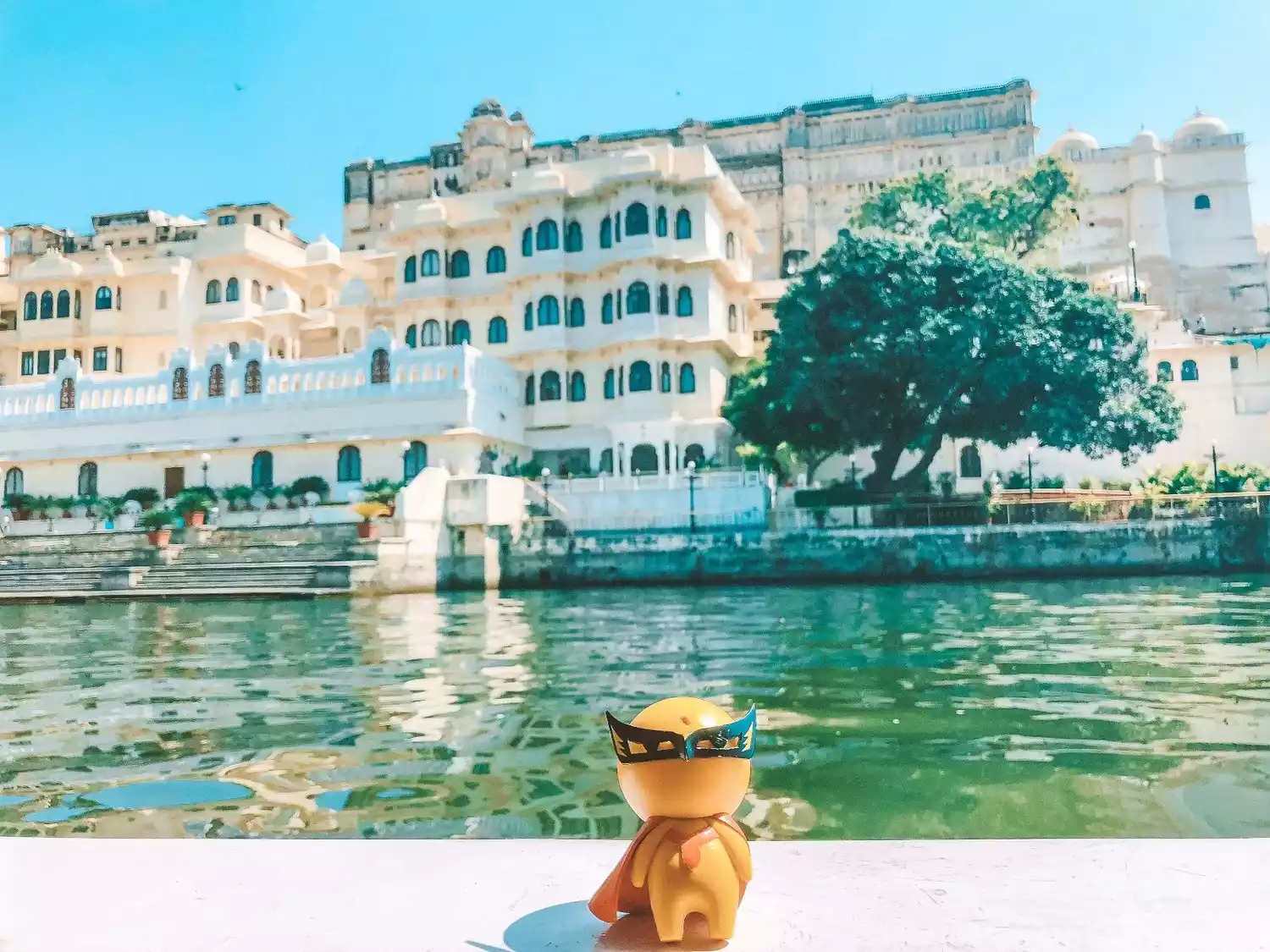
Lake Pichola is to Udaipur what West Lake is to Hangzhou. People say the White City is so clean it seems unbelievable, but in reality, it's Lake Pichola that separates it. The lake's east shore remains dingy and untidy. However, the west shore is lined with upscale, top-tier hotels. It's truly clean and beautiful, like a paradise. You can buy boat tickets at the entrance to the City Palace, and it's best to go in the afternoon. In the morning, the east shore is completely dark, making it difficult to see the City Palace. The afternoon light is much brighter. The boat ride takes about an hour, and the boat stops at the Jag Mandir Lake Palace (Island) for over half an hour. A few words about the Jag Mandir Lake Palace (Island), now a hotel. Rich Indians love to hold weddings on this small island.
Jag Niwas Lake Palace

It can be called the business card of Udaipur. It is the filming location of the 007 movie "Octopus". The second most luxurious Taj Lake Palace Udaipur in India is located on the island (I was fortunate to stay there. You need to make an appointment in advance. The cheapest single room is about 2K, which is quite affordable).
Remember, a trip to Udaipur is incomplete without splashing out the cash and experiencing a night in one of India’s luxurious hotels!
Tickets: Not open to the public, you can have a buffet on the island, the reference price is 300 RMB, reservations are required in advance; accommodation on the island starts from 3K
Ranakpur
This is a great place, located halfway between Jodhpur and Udaipur, where is located one of the most famous Jain temples in North India.
Ranakpur Jain temple


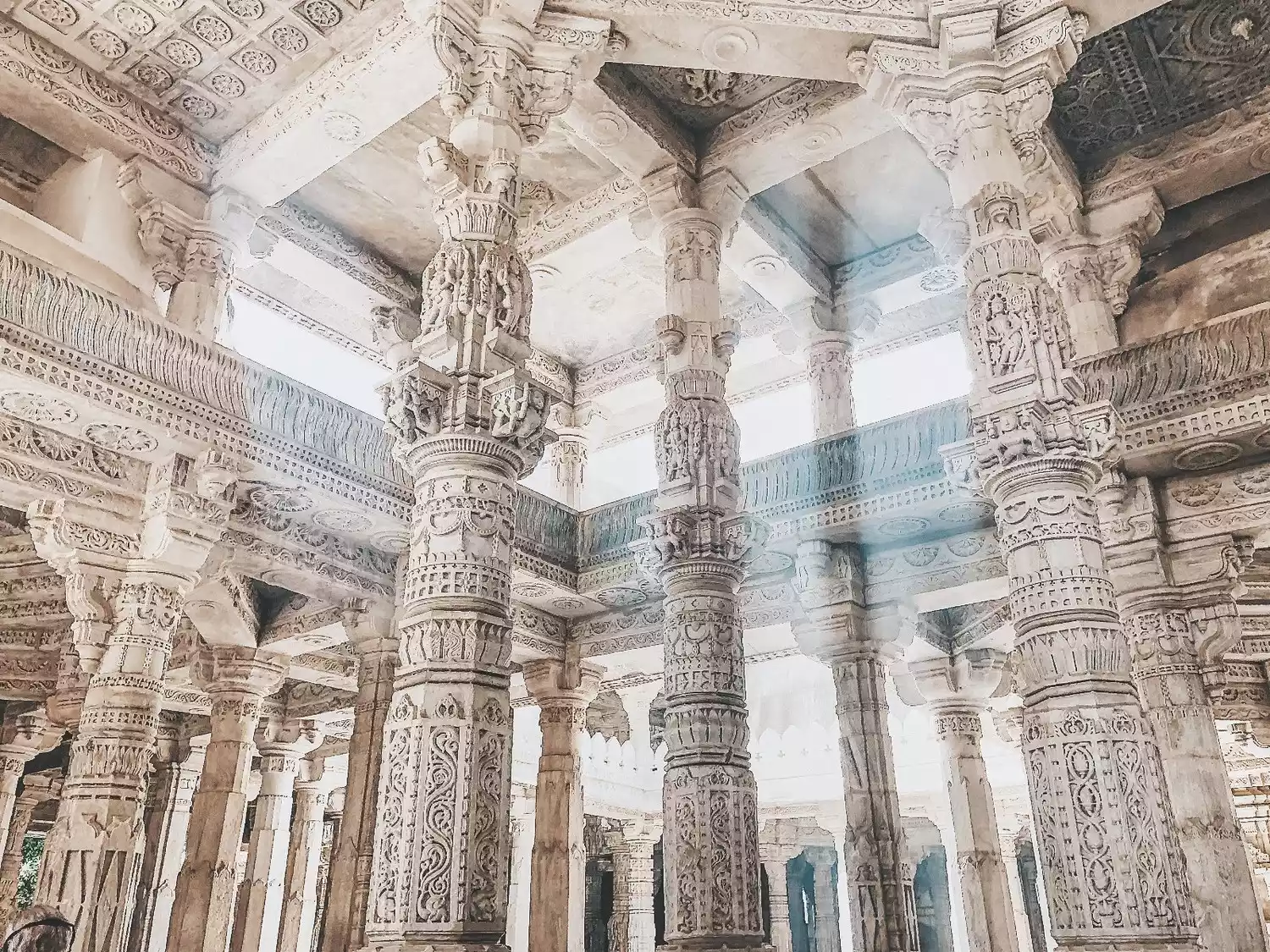

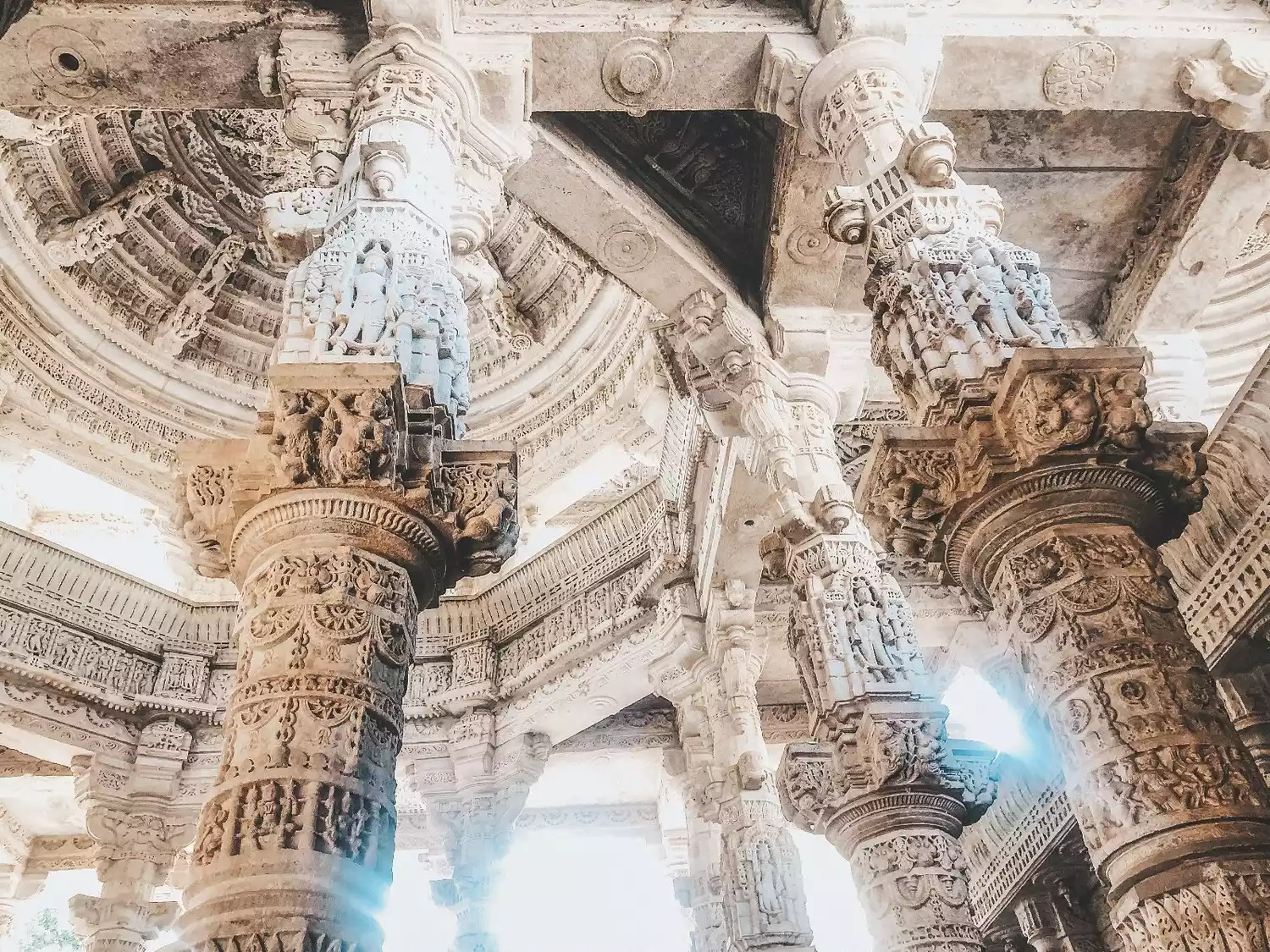


Yes, that's it. The Thousand Pillars Temple of Ranakpur!
One of the most important Jain temples, built of white marble, it was first documented in 1437. It is the largest, most exquisite, and most important temple in the Jain Ranapur complex. Its exterior is imposing, and the interior boasts breathtaking stone carvings. The temple is filled with 1,444 intricately carved marble columns, with no two carvings repeated. The beams and ceilings are also richly carved and remain remarkably well-preserved. It is the largest and most important Jain temple in India. Legend has
it that the temple's designer, Seth Dharna Shah, was a successful Jain businessman who dreamed of a celestial chariot described in Jain scriptures. This dream sparked his desire to build a temple in the shape of a chariot. Determined to realize his vision, he sought the help of the then-emperor, Rana Kumbha. The emperor supported his decision, granting him a large plot of land in a valley in the Aravalli Mountains and allowing him to build a town next to the temple. The condition was that the temple be named after the emperor. Seth Dharna Shah invited the best craftsmen and a large number of workers from India, and it took more than 60 years to finally build this miraculous temple.
Tips:
Ticket price: 200 rupees
Shooting requirements: Shooting with a mobile phone or camera requires an additional fee of 100 rupees, and shooting with a video camera requires an additional fee of 300 rupees.
Cameras and mobile phones need to buy separate tickets. Other photographic equipment such as iPads are not allowed to be brought in without tickets. Tools, water, snacks, meat products, and leather goods (belts, bags) are not allowed to be brought in. Shoes must be taken off when entering. There are areas inside that women are not allowed to enter. Tourists are not allowed to enter the statue area in the center.
Orccha

Almost every visitor to this place says it's their favorite stop of the entire trip. With its numerous temple complexes, Orchha resembles India's Bagan. The town is quiet and nearly tourist-free. The fortress is relatively untouched, and the murals inside are incredibly beautiful – well worth a few days to explore!
Jahangir Mahal Jahangir Palace



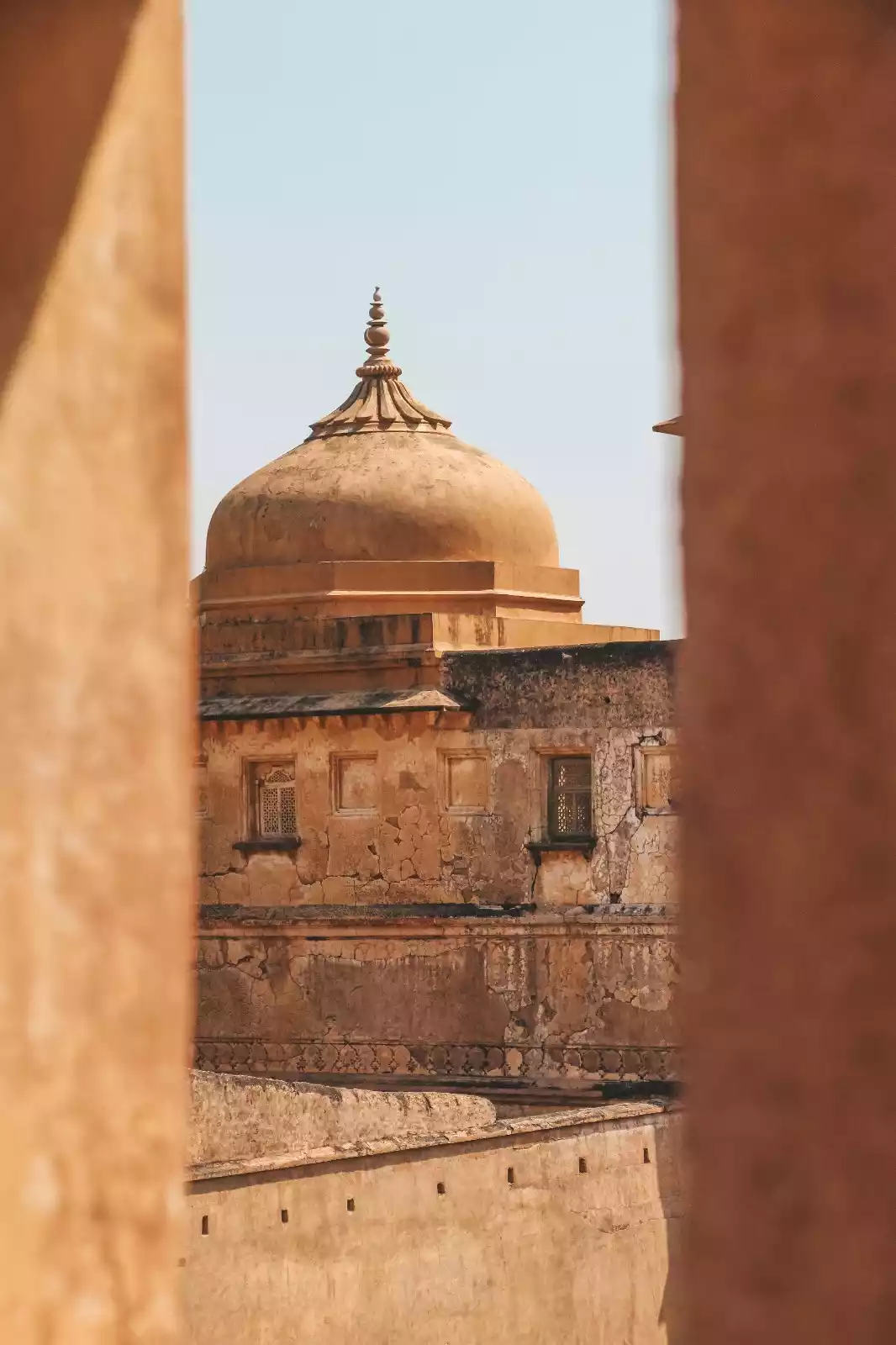





There are almost no tourists here, which can completely satisfy your fantasy of being the protagonist of "Tomb Raider"!
The most significant monument within Orchha Fort is the Jahangir Mahal, built in the 17th century by Raja Bir Singh Ju Deo. It is the fort's finest palace. Named Jahangir Mahal in honor of King Jahangir, who visited Orchha, the palace is a magnificent multi-story building that exemplifies the beauty of Hindu architecture in India. The ground floor houses a historical museum, offering breathtaking views from above.
Tips:
Ticket price: 250 rupees (great value)
Photo requirements: No additional charge, please take as many photos as you want
Ram Raja templeOrchha temple

Originally a palace, it was later transformed into a temple after a chance encounter with a statue of Lord Rama. The current Ram Temple refers to this new temple, while the even more magnificent Ram Temple next door is now partially sealed off and can only be visited from the main hall.
In the Ramayana, he is portrayed as both a prince in distress and a hero who triumphs over adversity. As the eldest son, he should have inherited the throne, but due to a conspiracy by Rama's half-mother to install her own son as king, he was exiled for 14 years. The only attendants accompanying the embattled prince were his wife Sita and his younger brother, Prince Lakshmana. In the forest, Sita was abducted by a Rakshasa king. Fortunately, with the help of the monkey god Hanuman, he defeated the Rakshasa and rescued Sita, who returned to the capital to become king. This sect believes that devout faith in Rama and the silent recitation of his name can lead to liberation. Rama worship is widespread in India.
Tips:
Admission: Free
Photo requirements: No additional charge, please take as many photos as you want
Khajuraho
Khajuraho Group of Monuments ( Temple of Love)




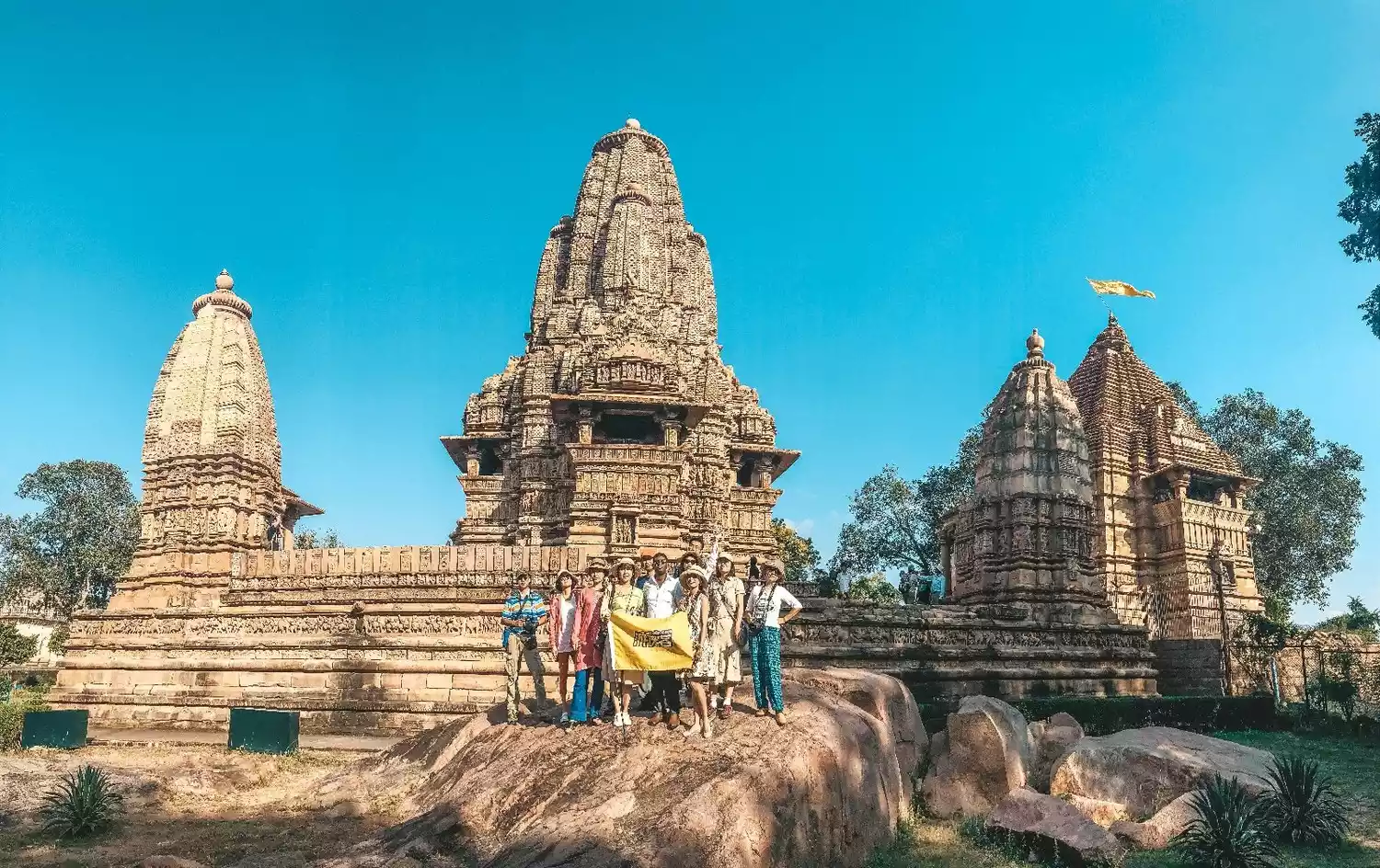



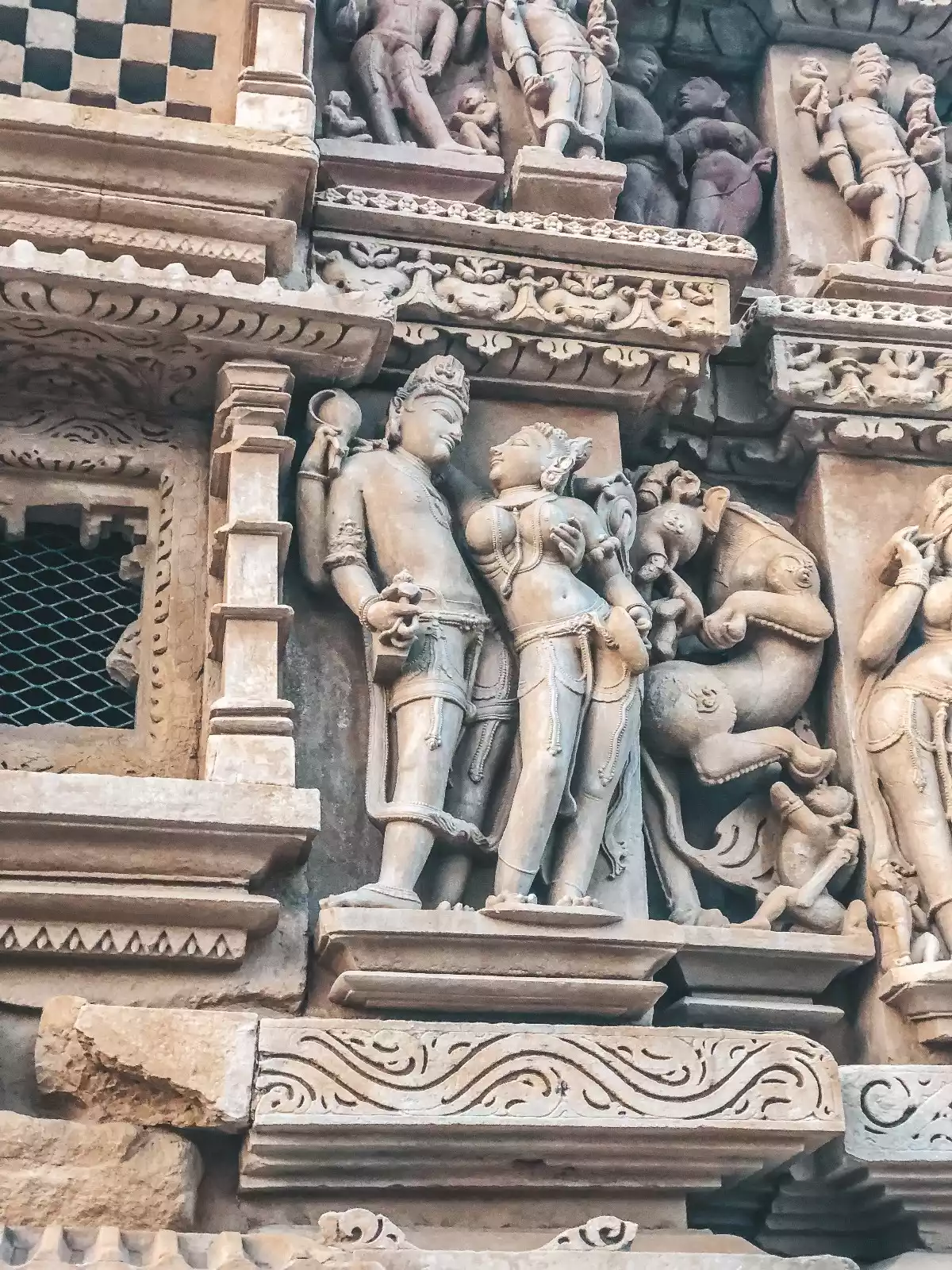
Isn’t it fun to find the highlights and learn the postures? Don’t forget that yoga also originated in India.
The Khajuraho West Temple Complex is surrounded by trees. Here, numerous buildings and carvings depicting divine eroticism are stacked layer upon layer on a hill-like tower that stretches toward the sky. The dense density of these structures is dazzling, and each one is vivid and full of life.
The East Temple Complex, belonging to the Jain faith, is smaller in scale, with only a few intact temples. These carvings depict the three main Indian deities: Brahma, Vishnu, and Shiva. The East Temple Complex is also a major temple of the Jain sect of the Gyalwa sect. We happened to catch the 108th Patriarch of Jainism giving a lecture there, and the gathering of monks and followers was a grand occasion. Jainism emphasizes asceticism, and the higher the level of monks, the less they wear clothes, "clothing themselves in the sky" in the pursuit of liberation. These naked monks are regarded as saints by the locals, and believers bow in respect wherever they pass.
Varanasi
Dasaswamedh Ghat Ganges Night Festival

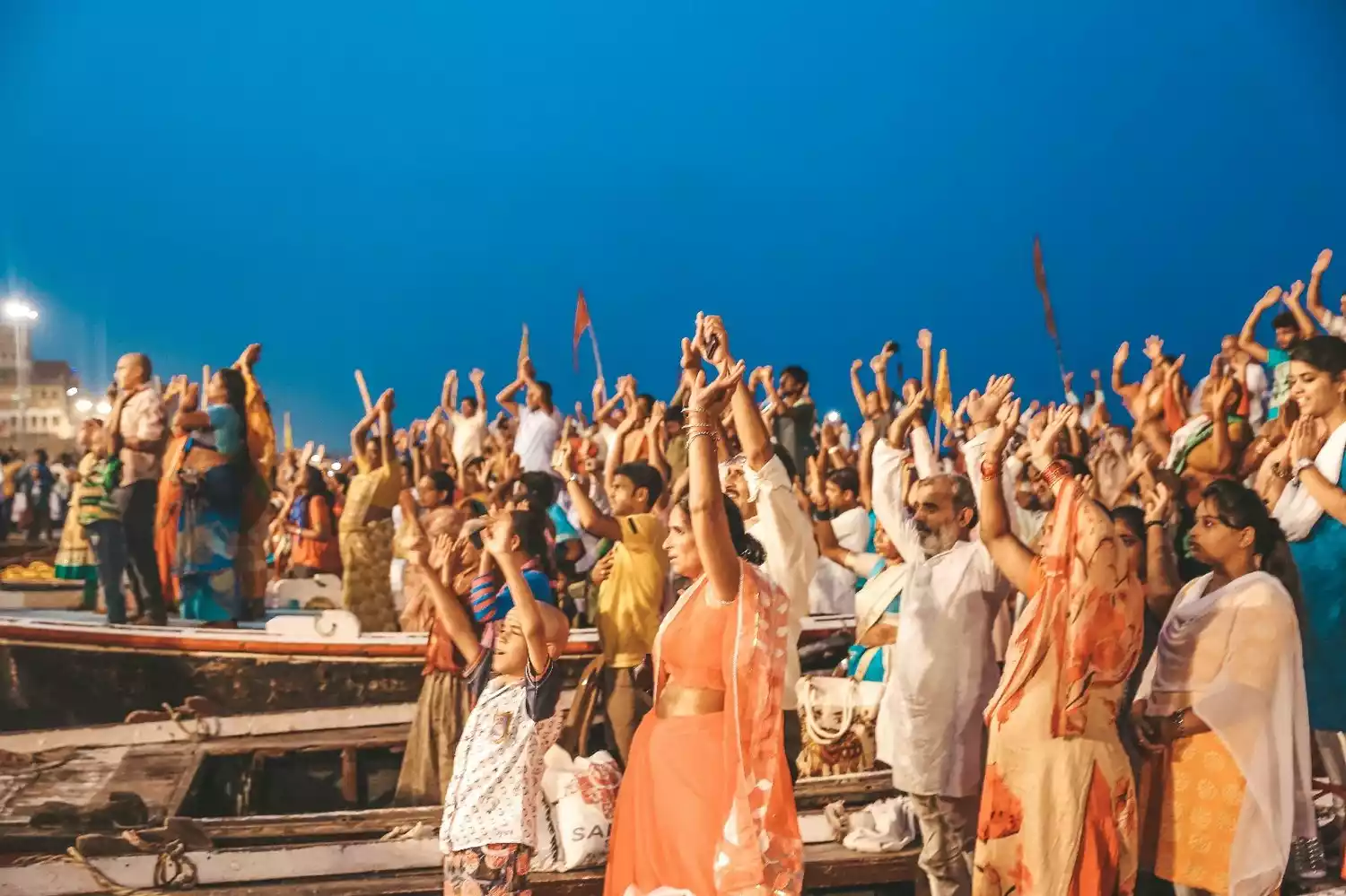





Dashashwamedh Ghat is Varanasi's principal ghat on the Ganges, located near the Vishwanath Temple. It is perhaps the most spectacular ghat. Two Hindu myths are associated with it: one claims that Brahma created it to welcome Shiva, and the other claims that Brahma sacrificed ten buffaloes in a fire sacrifice. Near Dashashwamedh Ghat, overlooking the Ganges, is an observatory built in 1737 by Jai Singh of Jaipur.

Although the night ceremony begins at 6:00 PM, people start arriving as early as 5:00 PM. By 5:30 PM, the altar is almost ready, and there are no good seats left. By 6:00 PM, it's completely packed. So, be sure to arrive early. Since the ceremony takes place directly on the water, for a more immersive experience, rent a boat with a group and experience the night ceremony from the front. This night ceremony is performed 365 days a year, and the staff are all Brahmins, outstanding students from the seminary.
Tips: Tickets: Open space, no entrance fee. It is recommended to spend 50-100 rupees to watch it from the boat on the Ganges, which has the best angle.
Sarnath
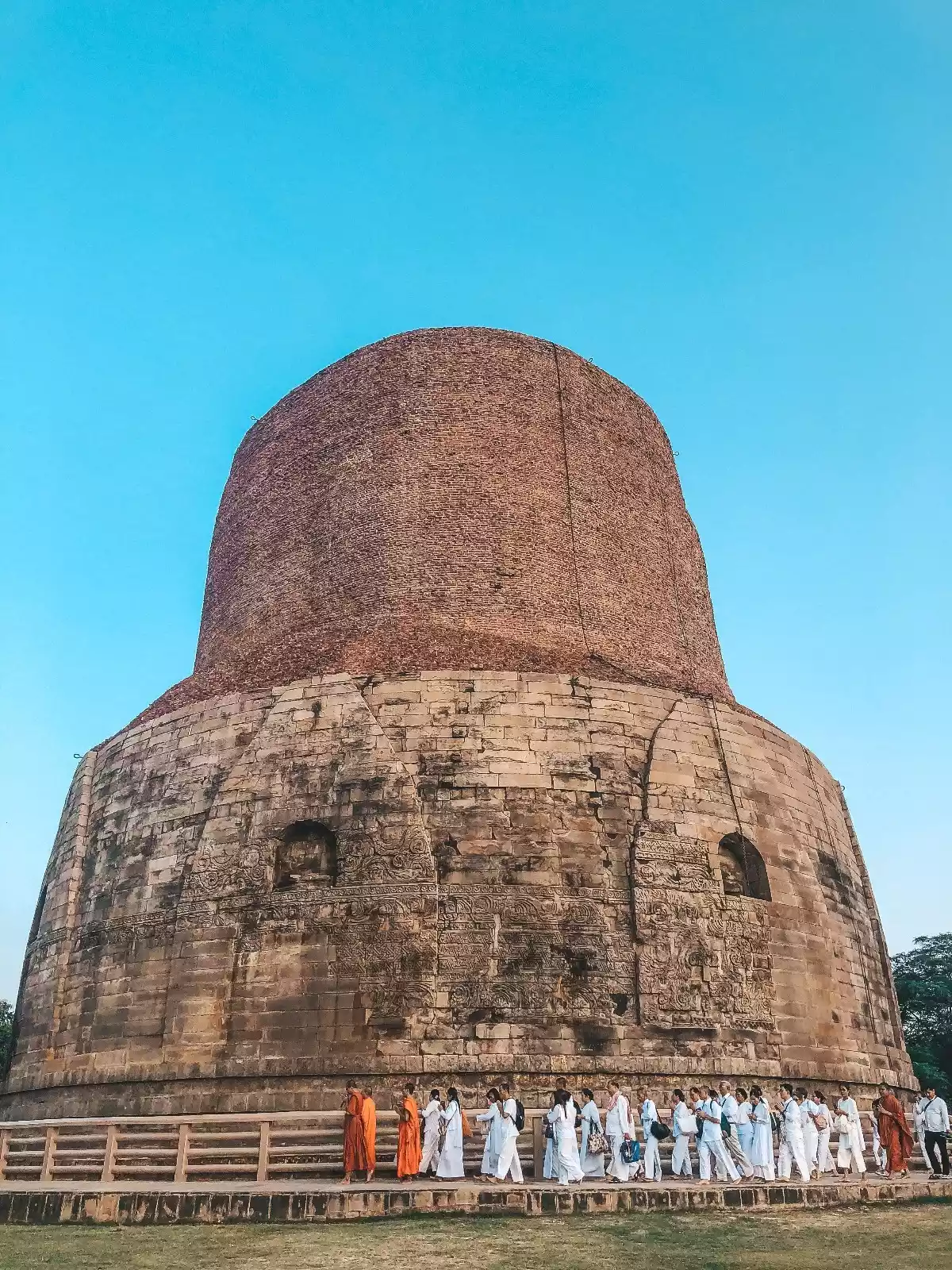

Sarnath, 10 kilometers north of the city, is the first place where Gautama Buddha preached after attaining enlightenment. Sarnath boasts the Archaeological Museum, Dhamekh Stupa, a Chinese temple, a Burmese temple, a Tibetan temple, and other sites. Pilgrimages from around the world are frequented year-round. Devotees sincerely hope to attain enlightenment at the sacred site where the Buddha preached. The Archaeological Museum also houses the Ashoka Pillar, a stone pillar from the reign of Emperor Ashoka, and various stone carvings, making it a truly memorable place to explore. The religious atmosphere of Sarnath creates a sense of tranquility and peace. Whether you're a Buddhist or not, experiencing this atmosphere here is truly worthwhile.
Buddha Shakyamuni sought the truth through asceticism, accompanied by five disciples. One day, he decided to abandon his asceticism and walked to a small river called Niranjana. After bathing, he chose to meditate under a bodhi tree. He was extremely emaciated, and a shepherdess brought him chyle to help him regain his strength. However, the five disciples, believing that the Buddha had given up on the search for the truth, left him. Together, the five disciples journeyed to Deer Park to continue his ascetic practice. When the Buddha finally realized the truth, he left Bodh Gaya and sought out his five disciples. Arriving in Deer Park, he approached his five disciples, but they ignored him. Miraculously, however, when the Buddha approached them, they spontaneously offered their seats for him. The Buddha then passed on his insights to his disciples, who became known as the Five Bhikkhus.
Tips:
Ticket price: US$100
Photography requirements: No mobile phones, cameras, backpacks or other electronic products or personal belongings are allowed
Manikarnika Ghat crematorium
Manikarnika Ghat is one of Varanasi's oldest ghats and the holiest cremation site for Hindus. Many Hindus come here for cremation, throwing their ashes into the Ganges in the hope of attaining liberation. Legend has it that the well on the riverbank was dug by Vishnu to please Shiva, who would spare the holy city when he destroyed the world. While bathing there, Shiva's earring fell into the well. Manikarnika means earring.
Tips:
Tickets: Open space, no entrance fee.
Please note that there are many Indian wildlife guides who will lobby you to donate cremation wood. Do not believe them, they are all scammers.
Conclusion
Of all the more than 70 countries I've visited, India is one I both love and hate. This somewhat contradictory feeling led me to set foot on this magical land again. The Indian Ministry of Tourism describes its own country as "Incredible India!" I think it's wonderful. Such a simple word conveys so much, and even after returning home for some time, I still can't get enough of it.





